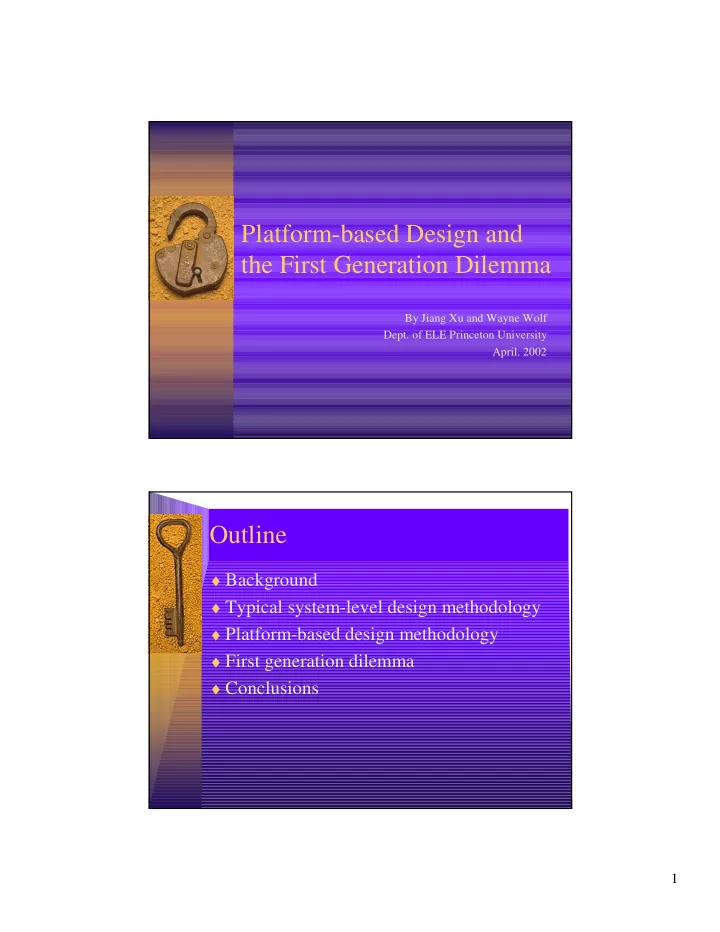

Platform-based Design and the First Generation Dilemma By Jiang Xu and Wayne Wolf Dept. of ELE Princeton University April. 2002 Outline ♦ Background ♦ Typical system-level design methodology ♦ Platform-based design methodology ♦ First generation dilemma ♦ Conclusions 1
Background ♦ Growing gap between design complexity and productivity. ♦ System-level design tool is a solution. ♦ Some system-level design tools. – Cadence Virtual Component Co-design(VCC). – CoWare N2C. – Synopsys CoCentric System Studio. – Innoveda Visual Elite. – Elanix SystemView. Typical System-level Design Methodology ♦ Besides specification, Experience/ Specification previous design Previous Designs experience is an important input for HW /SW system-level design. Partitioning Perform ance ♦ HW/SW partitioning is Analysis converted in function mapping. SW Refinem ent HW Refinem ent ♦ Performance analysis plays a more important role in PBD. Verification Integration – The accuracy of early performance analysis significantly affects Object Code following design steps. and Layout 2
Platform-based Design Methodology ♦ Three key steps Experience/ IP Cores and Specification Previouse Designs Customized Modules replace the typical HW/SW partitioning. Behavior Architecture Modeling Modeling ♦ Behavior modeling Performance Mapping ♦ Architecture Analysis modeling eases Interface Refinement PBD and IP reuse. VCC Boundary ♦ Mapping uses Software Hardware Co-verification trial-and-error Refinement Refinement method. Integration ♦ Close cooperation with other tools. Object Code and Layout Performance Analysis ♦ It takes place as early as in mapping step to get a quick estimation of a design. ♦ It helps timing requirements propagate through each design steps. ♦ Performance modeling is under surface. – Performance analysis is based upon performance models. – Accuracy of performance models is guaranteed by designers, so does accuracy of performance analysis. 3
Behavior Modeling Black Box White Box Clear Box Language C++, SPW, WhiteBox C STD, SDL, OMI Textual SDL Simulated Yes Yes Yes Analyzed No Yes Yes Synthesizing No No Yes ♦ Behavior model is used to capture specification details and develop HW and SW. ♦ Different languages are used. – Choosing programming style is an old and unsolved problem. ♦ White-Box C is preferable to others. Outline ♦ Background ♦ Typical system-level design methodology ♦ Platform-based design methodology ♦ First generation dilemma ♦ Conclusions 4
Another View of the PBD Methodology ♦ Two steps for architecture: choosing and mapping. ♦ Decisions of choosing platform and IP cores and designing customized modules are based upon performance analysis results. ♦ Performance analysis can not be made without IP cores or customized modules. First Generation Dilemma ♦ PBD assumes designers have enough IP cores and customized modules to build a platform. ♦ In many first generation designs, only a few IP cores and customized modules are in libraries. ♦ In the original PBD methodology, we can not: – Get performance results without enough IP cores and customized modules. – Choose IP cores and design customized modules without performance results. 5
A Way Out of the Dilemma ♦ First decide an architecture, Behavior Architecture Architecture and assign estimated Modeling Modeling Modeling requirements to unavailable modules. ♦ Adjust the requirements Performance Performance Mapping Mapping using performance analysis Analysis Analysis in a trial-and-error fashion. ♦ Based upon the requirements purchase IP cores and design Adjusting Adjusting customized modules. Requirements Requirements ♦ May need several iterations VCC Boundary to reach a final design. ♦ It is very helpful, if designers can get Choosing IP Cores Choosing IP Cores performance models of IP and Designing and Designing cores before buy them. Customized Modules Customized Modules Example -- A Multimedia Embedded Chip Available Unavailable SRAM IP Core Unavailable Customized Processor1 Processor2 SRAM Modules Controller Central Bus Arbiter DMA Media Smart Bridge Controller Accelerator Monitor Peripheral Bus Arbiter External PCI GPIO Memory Interface Interface 6
Conclusions ♦ First generation dilemma – PBD is not purely choosing-and-mapping, it still includes architecture design and module design. – Easily accessed performance models will be very helpful. ♦ Behavior modeling is a critical step in PBD, and modeling language is still an important issue. ♦ PBD needs a systematic method to guarantee performance analysis accuracy. 7
Recommend
More recommend